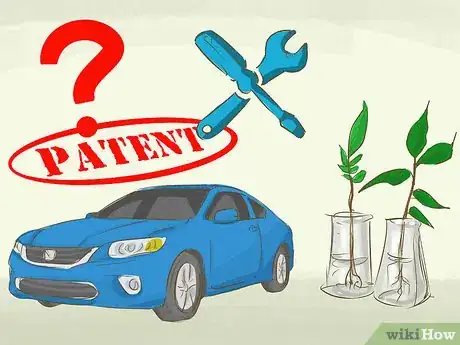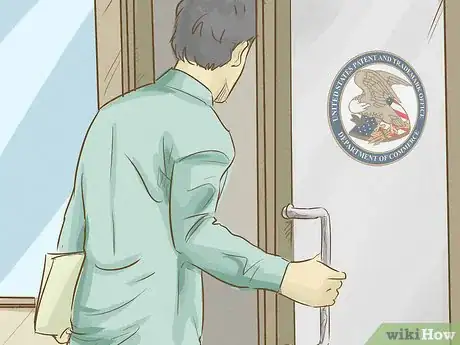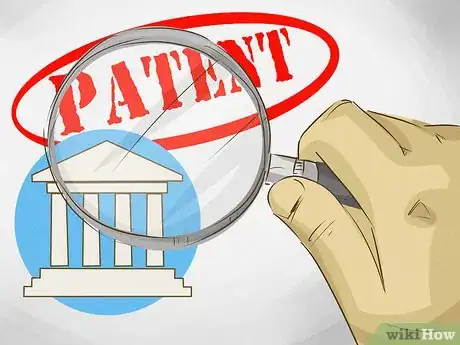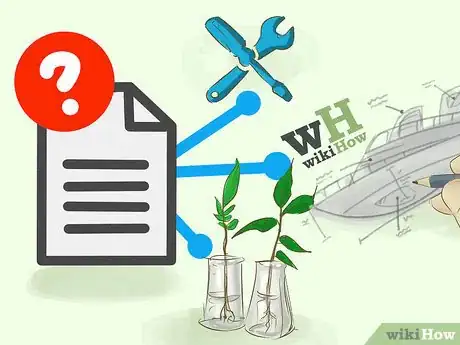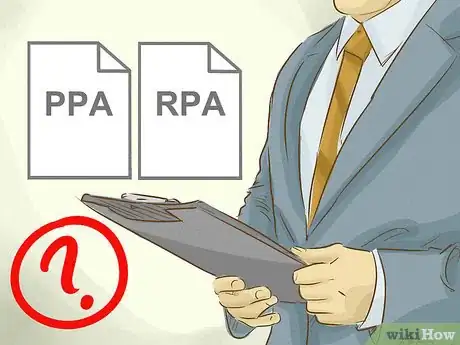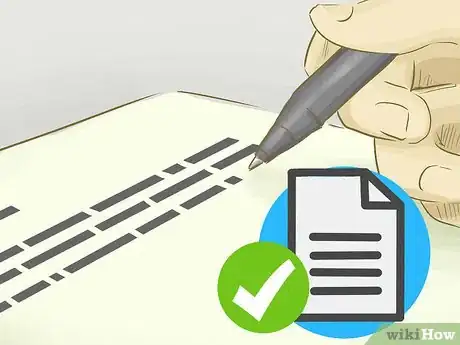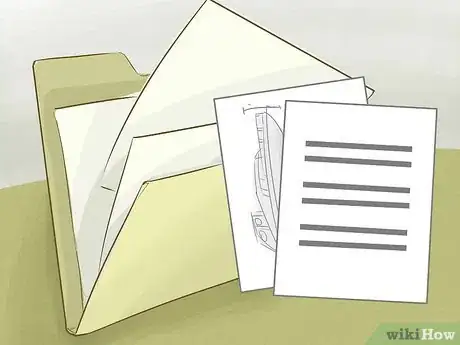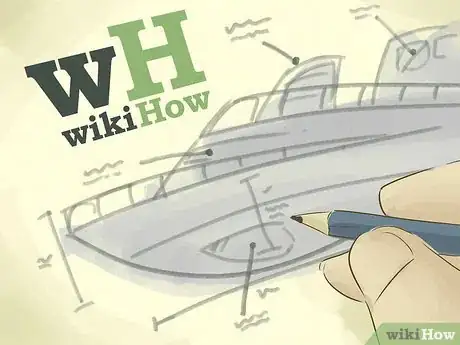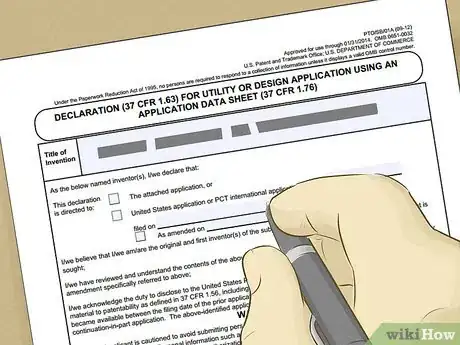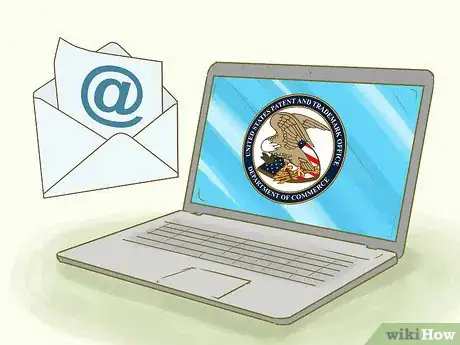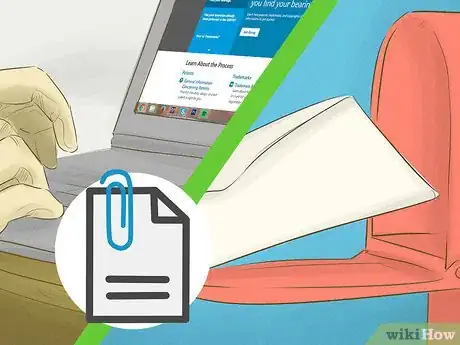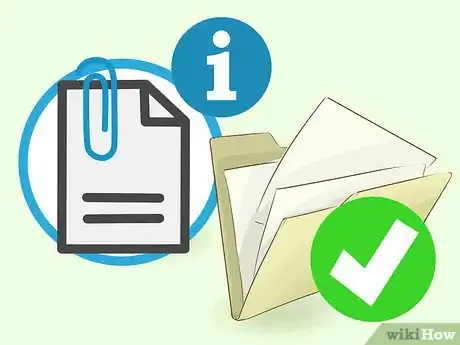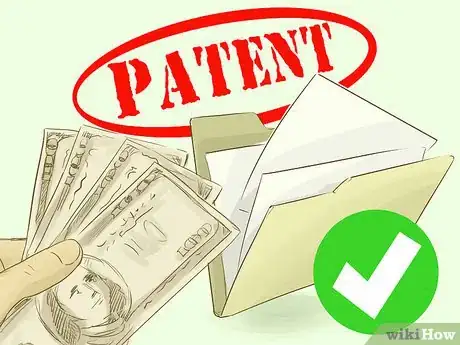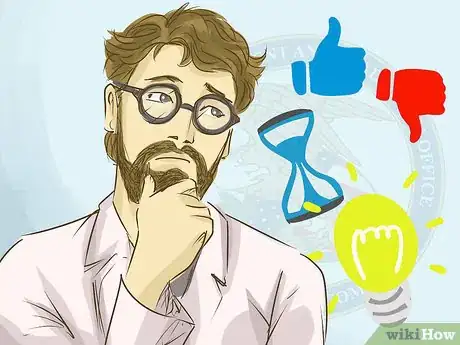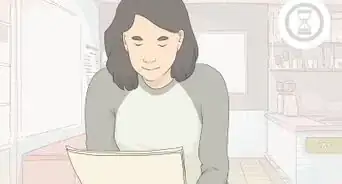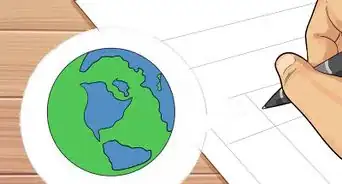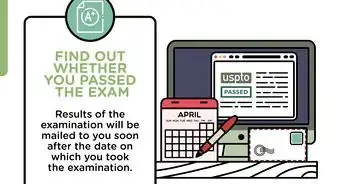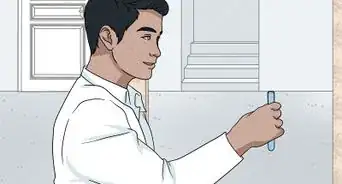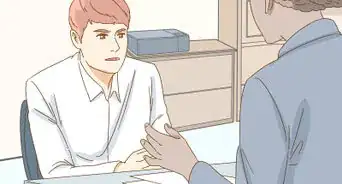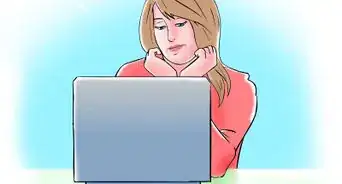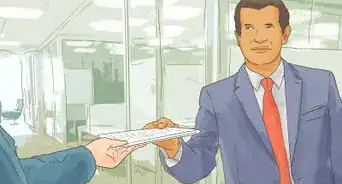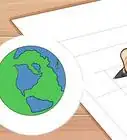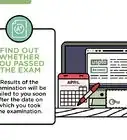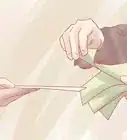This article was co-authored by Jeremy Rutman, PhD. Dr. Jeremy Rutman is a Patent Attorney and the CEO and Founder of RutmanIP, a boutique intellectual property firm in Israel. With over 15 years of experience, Dr. Rutman specializes in drafting patent applications in various fields such as physics, computer hardware and software, electrical engineering, mechanical engineering, green energy, and software. He holds a BS degree in Physics from Harvard University, where he graduated cum laude, and an MS and Ph.D. in Physics from the Technion - Israel Institute of Technology. Dr. Rutman has extensive experience turning start-up ideas into strategic assets and has published his work in many leading professional journals in the field.
There are 21 references cited in this article, which can be found at the bottom of the page.
wikiHow marks an article as reader-approved once it receives enough positive feedback. In this case, 89% of readers who voted found the article helpful, earning it our reader-approved status.
This article has been viewed 169,622 times.
A patent gives you, as owner, the ability to restrict others from making, using, selling, or importing your invention without your consent. Patents are awarded by the U.S. government to inventors, but may be owned by individual inventors, groups, or corporations.[1] The process is different for different countries, but no matter where you live, you’ll need to assess your prospects for successfully receiving a patent and then prepare and file any necessary paperwork. For most types of inventions, in the United States you have two filing options. You can file a provisional patent application (that holds your filing date and expires after one year) or a utility patent application.
Steps
Assessing your Patent Prospects
-
1Find out if your idea is eligible for a patent. You may be able to patent your idea if it is a process, a machine, a manufactured good, or an improvement of any of these.[2] For example, computer software may be a patentable product, because it is both a manufactured good. Similarly, if you design a software program that performs the same action as another program, but is more intuitive or uses a different aesthetic, you could apply for a patent on it also as an improvement. Patent-eligible inventions must be new, non-obvious (a function or result unexpected by those of ordinary skill in the field), and useful (able to provide a practical benefit).[3] Determine if your invention can honestly answer yes to these three qualifications. You will likely need to consult a legal professional to fully evaluate your invention in view of these legal concepts.
- Abstract ideas, natural phenomenon, and inventions with no utility are not eligible for a patent. For example, a zucchini is not eligible for a patent, because they occur in nature. Whereas, if you manage to breed a zucchini with another vegetable or produce a disease resistant zucchini strain, you may be eligible for a patent.
- An application claiming such things as "free energy" or "perpetual motion" are subject to additional scrutiny and challenge.
-
2Determine your patent category. There are three different types of patents offered by the U.S. Patent and Trademark Office.[4] If your innovation doesn't fall into one of these categories, it may not be patentable.
- A utility patent is granted for a new, original invention that has specific benefits for society. Patent protection offered by a utility patent lasts for 20 years from the day the patent is filed. This is the most common type of patent. For example, if you design a self-strapping diaper, you'd want to apply for a utility patent because your invention would perform a new function.[5]
- Apply for a design patent if your invention is a not a functioning item or process, but instead an ornamental design of an article of manufacture. Design patent protection lasts 15 years from the date the patent is granted.[6] This patent allows you to prevent other parties from copying the unique look of your product.[7] For example, new car models are released every year. The car serves the same function as previous cars, but is constructed with a different design. To deter rival car companies from producing identical cars, the car company files for a design patent.
- Pursue a plant patent for plant strains that you’ve developed through scientific engineering. This can be an important patent type in the agriculture industry as each company grows a specific strain designed to flourish in their geographic climate. Protection for a plant patent exists for 20 years from the original patent application date. However, many plants are additionally covered by utility patents if the plant performs a function such as resistance to a chemical. [8]
Advertisement -
3Make sure your idea hasn’t been patented or disclosed already. The invention or idea must differ in a significant way from other previous inventions. Search through past patents for similar inventions as yours and determine whether your idea is better or different enough to warrant its own patent.[9] Don't waste time and money developing an invention that someone else has already patented, disclosed in any publication or used in public. Searching through the huge database of patents, trade journals and other reference materials can be a complex and trying task.
- The elegance of searching other issued patents is that someone has already done the homework to show that those inventions were found patentable as of their respective filing dates. This allows you to focus on what further developments may have transpired in the field since that time. Be aware, however, that not all issued patents are equally valid and there may be "prior art" that everyone overlooked.
- Search the USPTO patent search site.[10] Here you can look for similar inventions using key words that describe the invention or that might be used in articulating how the invention works.
- Visit a patent depository library in your area for access to records and databases that are free to the public. Librarians with specific knowledge on patent searches can assist you with your research.[11]
- Check a database of scientific or trade journals for articles about similar inventions or topics. Issued patents frequently also reference useful document sources for further research.[12]
Preparing to File a Patent Application
-
1Find professional help. Completing the paper work alone for a patent can be daunting. Why not find someone who has successfully drafted and filed a similar patent in the past? There are several ways you can find professional help. You can hire a patent lawyer, ask for assistance from the United States Patent and Trademark Office (USPTO), check to see if your area offers free patent filing assistance, or visit a law school clinic. All of these sources should have thorough knowledge of patent law, helping to ensure that you complete the patent application successfully.
- Talk to an attorney. Patent attorneys must have an undergraduate degree in a science or engineering field, or equivalent education, and need to pass the patent bar exam.[13] Check the USPTO’s website in order to locate a patent attorney in your area.[14]
- Visit a law school with a patent clinic. At patent law clinics, you can ask questions relating to patent law and students gain real-life experience. This option is very good for those who cannot afford a bar approved patent lawyer, but still want legal advice. All of the advice given at these law clinic is vetted by a USPTO approved professor.[15]
-
2Find government sponsored patent assistance. In the United States and most other countries, the government will provide patent filing help as a way to promote upward mobility.
- Consider the USPTO’s Pro Se Assistance program. Pro Se is an outreach program to inventors who want to file a patent on their inventions. They will help you get started and assemble all the necessary documents to file a patent application. Their services are free, but appointments must be made for their physical location in Alexandria, Virginia.[16]
- Some states offer specialized patent programs. These “self-help” programs are designed to assist people with low incomes. Assistance is done pro bono, meaning done for free for the public good.[17] An initial assessment of your eligibility will be done prior to receiving pro bono assistance.
-
3Watch out for scams. There are many online sites that offer patent application assistance for an upfront fee. Often they’ll take your fee and leave you with nothing. In some of the worst cases, the company will actually steal your idea.[18] Search online for reputable patent assistance, before choosing which firm to go with.[19]
- What signals a scam? Scam artists will do everything they can to get money upfront and to refuse putting anything definitive in writing. They'll ask for money via phone or email, but they won't want to sign official contracts until a later date. Make sure that you sign contracts upfront. It is best to have a lawyer look over these contracts in advance to make sure that you aren't signing over your ideas or promising money without a guarantee of services.[20]
-
4Determine what kind of application to file. Pick an application based on your type of innovation. You'll either choose a design, plant, or utility patent.
- There is no "international patent", but you can apply for patent protection in other countries by filing separate patent applications in each one. Filing a PCT application (Patent Cooperation Treaty) or an EU application (European Union) are some easier methods of applying to more than one country. Foreign patent protection can help protect you from companies that want to sell similar products in the United States through the "gray market". Your US patent will allow you to prevent them from importing your invention without a license. The US has patent agreements with various countries around the world. This will help protect your product in some cases, but if you want to protect your rights within other countries, on a global scale, you'll have to apply for patents in every country.
- You can file for expedited examination to get your patent approved faster. Since many patent applications take years to be approved or rejected, you may consider this option. However, it is typically extremely expensive.
- Many people file a US provisional patent application while they finalize their patent strategy or wait for financial backing to move to production.[21] A provisional application reserves the right to apply for a patent on the disclosed invention for up to a year. You may file as many provisional applications as necessary to fully document your invention as it evolves.
-
5Pick a filing strategy. Your filing strategy will depend on whether you need immediate protection for your invention and whether or not you are prepared to make a formal patent claim. There are two filing strategies to consider:
- File a US provisional patent application (PPA). Filing for a PPA is less expensive and less complex than filing a regular patent application but offers no enforceable protection. A PPA allows you to claim "patent pending" on your invention. The PPA requires a fee (usually $70-$280), a detailed and enabling description of your invention, and basic drawings of your invention.[22] A provisional patent application allows the inventor to prove a date of invention priority for up 12 months before filing an application for a patent. A PPA requires that the inventor apply for a non-provisional patent within the year, specifically referencing one or more unexpired PPAs, as desired.[23]
- File a US non-provisional, regular patent application (RPA). A patent, when granted, protects an invention for up to 20 years from its effective filing date, or 15 years from grant of a design patent. In order to receive a patent, you must disclose information to enable others to carry out the invention, explain its novelty, and describe what parts of invention should be patented. The RPA process typically takes years, due to a thorough examination by the US Patent & Trademark Office. There are specific rules about each required part and the order in which they must be presented.
-
6Fill out the appropriate patent application cover sheet. The full application will include numerous specific parts and pertinent information, such as a title, abstract, detailed description of the invention, how the invention works and relevance of the drawings to the invention being claimed. Your patent will almost always include drawings and schematics—any technical details needed by others to implement your invention. Make sure to have your lawyer look it over before submitting it.[24]
-
7Complete a “specification attachment”. This is the narrative portion of the patent application. It should include descriptions of the type of invention, any prior iterations of the product, the invention’s purpose, a detailed description of how it is assembled, and how it works.[25]
- The specification statement also includes patent claims and an abstract. The claim portion of the statement is often the most important and the most difficult. Having a patent attorney or some other professional counsel is essential for this portion of the patent form. It should be written as a series of sentence fragments that succinctly describe the invention in question.[26]
- For example, an “independent” claim for a "ziplock" bag could be: A bag closure comprising a flat body of material having a lead-in notch on one edge thereof, and a gripping aperture adjacent to and communicating with said notch.[27]
- A "dependent" claim refines the invention described in the independent claims. For example, "The bag closure recited in claim one, where said bag closure is made of flexible plastic".
- The patent claims are what become your exclusive "property" when the patent is issued. Sometimes one or more of the dependent claims must be merged to obtain a new, but narrower, independent claim that is deemed patentable.
-
8Prepare any necessary drawings. Almost every patent application requires drawings of the invention. These should be as technical as possible. They should also emphasize those elements that strengthen your patent case. If your invention uses energy more efficiently, highlight the portions of the design that show that. If you are applying for a design patent, make sure that your design innovations are emphasized.
- If you are not a skilled artist, you can usually hire a patent drafts person to prepare these drawings for around $75 to $150 per drawing sheet. These artists will also know what drawing specifications the government accepts.[28]
-
9Include an oath. Every patent form requires an oath to be signed and notarized stating who created the invention. The necessary 2 page oath form can be found online.
- In lieu of a notarized oath, an application may also include a sworn declaration, the validity of which is presumed from the fact that making a false declaration would be a felony.
Filing Your Application
-
1Submit your patent application electronically. You may do this electronically. Utility and design patents can be filed electronically from the website of the United States Patent and Trademark Office. Filing digitally ensures that your application is secure and delivered successfully.[29] For help completing the form, contact the USPTO at 1-800-PTO-9199 (1-800-786-9199) and select option 2.
-
2Send your patent application by mail. If you prefer to print and mail your patent application, you may. Be aware that submitting your patent application by mail is more expensive than filing online. All three types of patents (utility, design and plant) can be applied for manually. Applications for plant patents must be submitted in physical form. The forms can be found online.[30]
- Mailing an application will introduce a large delay into the processing due to physical security concerns and the process in the USPTO for digitizing your submissions prior to further evaluation.
-
3Include additional documents. When you send in your application, you should include a self-addressed, stamped receipt postcard (if sending through the mail). You should also include an Information Disclosure Statement and a Patent Application Declaration.
- The Patent Application Declaration states that you are the inventor of the item or idea for which you are submitting the patent application.
- The Information Disclosure Statement requires you to disclose anything else to the application that may be relevant to your application such as another, similar application and the most relevant inventions you found in your research. If filed more than 3 months after the application, additional fees will apply.
-
4Pay the filing fee. Applying for a patent isn't free—in fact it can be very expensive. You will need to pay a fee based on the type of application you file and when you file the application, along with other factors.[31] For example, an application with excessive pages or claims require more fees. Additional fees will become due when and if your patent application is successful and moves to "issuance". Consult the USPTO.gov website for specific fees.
- There is the basic application fee, a "search" fee and an "examination" fee, plus possibly other fees for translation, or if any fees are filed late.
EXPERT TIPHarish Chandran is the Engineering Site Lead and Senior Staff Research Engineer at DeepMind, where he leads the engineering efforts to integrate AI research results into Google products. Harish received his PhD in Computer Science from Duke University in 2012. While in graduate school, he worked as a Teaching Assistant, helping undergraduate students learn about algorithms and data structures. He has experience in DNA self-assembly, evolutionary algorithms, computational neuroscience, complexity theory, computer architecture, and super-computing.Machine Learning Engineer & PhD in Computer Science, Duke University
 Harish Chandran, PhD
Harish Chandran, PhD
Machine Learning Engineer & PhD in Computer Science, Duke UniversityThe cost to file a patent may depend on where you live. Machine learning engineer Harish Chandran says: "Because patents are filed in specific countries, the cost can vary depending on the jurisdiction of your department. In the US, a patent may cost around $10,000. If you want to file globally, you might pay $30,000-$40,000."
-
5Wait for your patent to be approved or denied. The application process takes time as patent examiners research your patent application claims—sometimes several years. There is a huge backlog of patents waiting to be looked at.
- Your application may be rejected because it claims something already known in the state of the art when you filed. You may choose to narrow your claims, as necessary.
- Your application may be "objected to" because it violates any of the rules about the form of a proper patent application.
- Do not proceed with your invention if your patent application is denied because the same product or process is protected by a patent. This is called patent infringement and it is punishable by being sued, which may result in money damages or having your products confiscated.
-
6Respond to the USPTO's actions, if needed. If your patent is rejected, you can argue the basis for the rejection or make amendments to your claims. You cannot add new materials to your application without losing your filing priority of invention. If you decide to file new material, consult a patent attorney. The last thing you want to do is resubmit your patent application several times. Better your chances by having a patent attorney look over your documentation prior to filing anything.
- You are typically given a limited time in which to respond to an "office action" by the USPTO examiners. Failure to reply within the limit and any extensions you purchase will result in a presumption of abandonment of your application.
- In response to a rejection you may submit an argument and amendment and then receive a further rejection on that response, making it "final". You may choose to appeal that finding or to reconsider the value of continuing the case in its present form.
- You may be allowed patentability on some claims and not others. You can then decide whether to obtain an "issuance" of the allowed claims immediately, or to pursue further arguments and amendments on these and the rejected claims.
- Further applications may be filed at any time, claiming a modification that you developed later. Properly cross-referencing multiple applications is complicated and will probably require assistance of a registered patent attorney.
Expert Q&A
-
QuestionIs it hard to get a patent?
 Harish Chandran, PhDHarish Chandran is the Engineering Site Lead and Senior Staff Research Engineer at DeepMind, where he leads the engineering efforts to integrate AI research results into Google products. Harish received his PhD in Computer Science from Duke University in 2012. While in graduate school, he worked as a Teaching Assistant, helping undergraduate students learn about algorithms and data structures. He has experience in DNA self-assembly, evolutionary algorithms, computational neuroscience, complexity theory, computer architecture, and super-computing.
Harish Chandran, PhDHarish Chandran is the Engineering Site Lead and Senior Staff Research Engineer at DeepMind, where he leads the engineering efforts to integrate AI research results into Google products. Harish received his PhD in Computer Science from Duke University in 2012. While in graduate school, he worked as a Teaching Assistant, helping undergraduate students learn about algorithms and data structures. He has experience in DNA self-assembly, evolutionary algorithms, computational neuroscience, complexity theory, computer architecture, and super-computing.
Machine Learning Engineer & PhD in Computer Science, Duke University Machine Learning Engineer & PhD in Computer Science, Duke UniversityExpert AnswerYes, it can be tricky. To patent an idea, you should be able to prove that you can apply that idea in the real world to perform something tangible. You also need to demonstrate that the patent is enforceable, or you'll be able to detect whether someone else is using your idea in their product. You also have to prove that no one else is using that idea anywhere, and that the idea has value.
Machine Learning Engineer & PhD in Computer Science, Duke UniversityExpert AnswerYes, it can be tricky. To patent an idea, you should be able to prove that you can apply that idea in the real world to perform something tangible. You also need to demonstrate that the patent is enforceable, or you'll be able to detect whether someone else is using your idea in their product. You also have to prove that no one else is using that idea anywhere, and that the idea has value. -
QuestionHow much do patents cost?
 Barzin Barry Sabahat, JDBarry Sabahat, Esq. has been practicing law in California since 1993. He received his JD from Western State University College of Law in 1992. His current practice is based in the San Francisco Bay Area and focuses on Estate Planning, Transactional Law and drunk driving cases.
Barzin Barry Sabahat, JDBarry Sabahat, Esq. has been practicing law in California since 1993. He received his JD from Western State University College of Law in 1992. His current practice is based in the San Francisco Bay Area and focuses on Estate Planning, Transactional Law and drunk driving cases.
Attorney at Law Fees vary widely depending on the type of patent. For example, the basic filing fee for a micro entity patent is $70, but there are many additional fees that may apply. Therefore, you could end up paying anywhere from a few hundred to thousands of dollars depending on the patent you need. You may need to consult an attorney to find out exactly how much your patent will cost. You can also check the full USPTO fee schedule online.
Fees vary widely depending on the type of patent. For example, the basic filing fee for a micro entity patent is $70, but there are many additional fees that may apply. Therefore, you could end up paying anywhere from a few hundred to thousands of dollars depending on the patent you need. You may need to consult an attorney to find out exactly how much your patent will cost. You can also check the full USPTO fee schedule online. -
QuestionHow old do I need to be to file a patent?
 Barzin Barry Sabahat, JDBarry Sabahat, Esq. has been practicing law in California since 1993. He received his JD from Western State University College of Law in 1992. His current practice is based in the San Francisco Bay Area and focuses on Estate Planning, Transactional Law and drunk driving cases.
Barzin Barry Sabahat, JDBarry Sabahat, Esq. has been practicing law in California since 1993. He received his JD from Western State University College of Law in 1992. His current practice is based in the San Francisco Bay Area and focuses on Estate Planning, Transactional Law and drunk driving cases.
Attorney at Law You do not need to be any particular age to file a patent since there is no age limit.
You do not need to be any particular age to file a patent since there is no age limit.
References
- ↑ http://www.uspto.gov
- ↑ PATENT AND TRADEMARK OFFICES: U.S. DEPARTMENT OF COMMERCE MANUAL OF PATENT EXAMINING PROCEDURE: CHAPTER 2100 PATENTABILITY, §§ 2104 - 2106.
- ↑ Jeremy Rutman, PhD. Patent Attorney. Expert Interview. 5 January 2021.
- ↑ http://www.uspto.gov/patents-getting-started/general-information-concerning-patents#heading-1
- ↑ http://www.wisegeek.com/what-is-the-difference-between-a-design-patent-and-a-utility-patent.htm
- ↑ 35 USC § 173 (as amended 2012)
- ↑ http://www.uspto.gov/patents-getting-started/general-information-concerning-patents#heading-1
- ↑ http://www.uspto.gov/patents-getting-started/general-information-concerning-patents#heading-1
- ↑ Jeremy Rutman, PhD. Patent Attorney. Expert Interview. 5 January 2021.
- ↑ http://www.uspto.gov/patents-application-process/search-patents
- ↑ http://www.uspto.gov/learning-and-resources/support-centers/patent-and-trademark-resource-centers-ptrc/ptrc-locations
- ↑ Jeremy Rutman, PhD. Patent Attorney. Expert Interview. 5 January 2021.
- ↑ http://www.ipwatchdog.com/patent-bar-exam/patent-bar-qualifications/
- ↑ https://oedci.uspto.gov/OEDCI/
- ↑ http://www.uspto.gov/learning-and-resources/ip-policy/public-information-about-practitioners/law-school-clinic-1
- ↑ http://www.uspto.gov/patents-getting-started/using-legal-services/pro-se-assistance-program#heading-4
- ↑ http://www.uspto.gov/patents-getting-started/using-legal-services/pro-bono
- ↑ http://www.uspto.gov/patents-getting-started/using-legal-services/scam-prevention
- ↑ http://www.consumeraffairs.com/invention-services/
- ↑ http://www.uspto.gov/sites/default/files/web/offices/com/iip/documents/scamprevent.pdf
- ↑ Jeremy Rutman, PhD. Patent Attorney. Expert Interview. 5 January 2021.
- ↑ Jeremy Rutman, PhD. Patent Attorney. Expert Interview. 5 January 2021.
- ↑ PATENT AND TRADEMARK OFFICES: U.S. DEPARTMENT OF COMMERCE MANUAL OF PATENT EXAMINING PROCEDURE: CHAPTER 600 PARTS, FORM, AND CONTENT OF APPLICATION, § 601
- ↑ PATENT AND TRADEMARK OFFICES: U.S. DEPARTMENT OF COMMERCE MANUAL OF PATENT EXAMINING PROCEDURE: CHAPTER 600 PARTS, FORM, AND CONTENT OF APPLICATION, § 601
- ↑ PATENT AND TRADEMARK OFFICES: U.S. DEPARTMENT OF COMMERCE MANUAL OF PATENT EXAMINING PROCEDURE: CHAPTER 600 PARTS, FORM, AND CONTENT OF APPLICATION, § 601.
- ↑ PATENT AND TRADEMARK OFFICES: U.S. DEPARTMENT OF COMMERCE MANUAL OF PATENT EXAMINING PROCEDURE: CHAPTER 600 PARTS, FORM, AND CONTENT OF APPLICATION, § 601.
- ↑ Patent, Copyright & Trademark: An Intellectual Property Desk Reference, Richard Stim, 9th Edition (pgs. 147-149).
- ↑ http://www.uspto.gov/patents-getting-started/general-information-concerning-patents
- ↑ http://www.uspto.gov/web/forms/sb0125_fill.pdf
- ↑ http://www.uspto.gov
- ↑ Jeremy Rutman, PhD. Patent Attorney. Expert Interview. 5 January 2021.
About This Article
Before you get a patent, make sure that your idea is new, non-obvious, and useful. If your idea meets those requirements, gather supporting documents, like the Patent Application Declaration and a specification statement that gives the features and utility of your idea or product. Then, visit the United States Patent and Trademark Office's website to file your patent. You should prepare to pay several fees which can range in cost. Once you've submitted your application, wait for your application to be approved or denied. For advice from our Legal reviewer on how to determine your patent type, read on!


